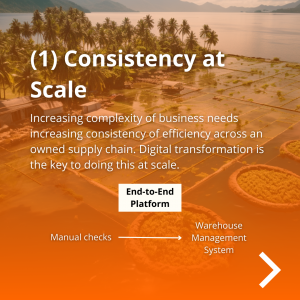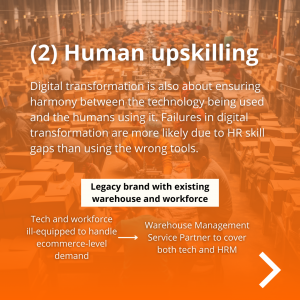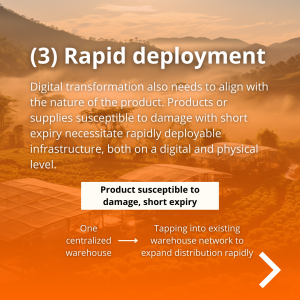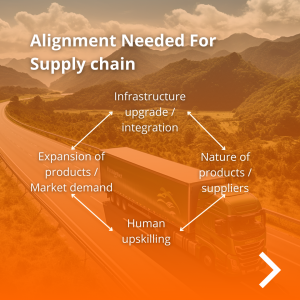With improved distribution efficiencies in various industries thanks to O2O platforms / marketplaces connecting buyers and sellers, the demand for supply chain and payments to keep up has only increased.
For logistics specifically, one of the bigger challenges has been to maintain service quality, accuracy, and reliability at scale. This is even more of a challenge for commerce companies managing several layers of distribution (say from source materials to production or manufacturing to distributors / wholesalers to the end consumer) that require the use of warehouse networks. Add to that the constraints posed by Indonesia’s sprawling archipelagic geography and the pain points become even clearer.
In this article, we explore the work on the ground of Indonesian logistics tech company Shipper, and how their warehouse solutions in particular are able to close the gap between quality and scale for some of the largest brands in Indonesia. Through this, we gain some insight into what it takes to implement digital transformation from a supply chain and logistics standpoint.
- Supply chain digital transformation means alignment in pace of product/service rollout with supply chain operations.
- Supply chain digital transformation means alignment in pace of human upskilling with technology upgrades.
- Supply chain digital transformation means alignment in pace of implementation with needs/nature of the product being shipped/distributed.
This article is based on the official press releases and articles published on the Shipper website in the last three months around three case studies across three different industries.
Case 1: Supply Chain Digital Transformation through Warehouse Management System resulting in 90% delivery accuracy rate

Supply chain consistency at scale
Insight: Increasing complexity of business needs increasing consistency of efficiency across an owned supply chain, and digital transformation is the key to doing this at scale. Manual checks are no longer efficient for an end-to-end platform supporting hundreds of thousands of suppliers across 280 cities. Warehouse management system (WMS) solutions present a needle-moving alternative to track the flow of goods more accurately and better optimized distribution.
Company: Established in 2013, eFishery has revolutionized traditional fish and shrimp farming methods by providing sophisticated solutions within the aquaculture ecosystem. They offer an end-to-end platform that provides access to feed, funding, and markets for fish and shrimp farmers.
With the goal of addressing food issues, aquaculture industry challenges, and social and economic disparities, eFishery has become a partner to over 200,000 fish and shrimp farmers in 280 cities/districts across Indonesia.
Pain Point: In ensuring the efficiency of this end-to-end platform, eFishery has encountered a number of logistics challenges, such as stock and seed management in their warehouses. Manual checks often lead to data recording errors and time-consuming reporting, hindering operational activities and affecting farmers.
Solution: To address this issue, eFishery decided to partner with Shipper, specifically leveraging their dedicated warehouse service equipped with a Warehouse Management System (WMS).
As leaders from both eFishery and Shipper share in the official press release of the partnership:
“…The flow of goods from entry to exit can be managed more efficiently, allowing faster and more accurate distribution of feed to customers. As a result, eFishery has achieved a 90% delivery accuracy rate, providing satisfaction to farmers and end customers,” said Cita Rezkiani, VP of Operations & Supply Chain Upstream at eFishery.
“The collaboration between eFishery and Shipper is expected to consistently provide a positive impact on warehouse operations for customer satisfaction. With the assistance of the WMS system provided by Shipper, eFishery can improve stock recording and manage the flow of goods in their warehouse. The distribution of feed to customers can be done faster, thus helping to produce quality and professional cultivation,” said Budi Handoko, COO of Shipper.
More details in the published press release
Case 2: How when Digital Transformation is also HR Transformation can result in 60% growth YoY

Supply chain workforce upskilling
Insight: Digital transformation is not just about plugging in technology; it’s also about ensuring harmony between the technology being used and the humans using it.
As the following case points out, “Unfortunately, many companies focus too much on the technological aspect and ignore another important aspect: increasing the digital capabilities of HR. Data shows that 39% of failures in implementing digital transformation are caused by HR skill gaps, while only 4% are caused by inappropriate technology selection. This is also a major challenge for companies in making digital transformation a success.”
Partnering with companies with the right technology and experience to manage warehouses can be instrumental in aligning human upskilling (as opposed to manpower replacement) with use of digital tools.
Company: Bata is a multinational company that focuses on the production and sale of shoes.
Pain Point: Previously, Bata had operated its own warehouse, but was not yet fully equipped with advanced technology and a workforce that had sufficient qualifications to carry out its operations.
Soaring online market demand post-pandemic has put pressure on their supply chain management, and Bata realized that they need to focus on the digital competence of their human resources to ensure their supply chain keeps up with demand.
Solution: Bata collaborated with Shipper to manage its warehouse operations through the latter’s warehouse operational takeover service, so that it is able to adapt to changes in online shopping behavior that continues to develop.
Importantly, this management service covers both system management and human resources, meaning Shipper ensures that the entire supply chain and logistics process from Bata runs automatically with the support of operators who have the capability to operate the existing system.
The synergy between Bata and Shipper has resulted in significant business growth in 2022, achieving an increase of 60% YoY, with 10,000 orders processed every day 10,000 daily orders with an SLA guarantee of being on time and error free.
More details in the published case study
Case Study 3: How Supply Chain Digital Transformation Can Be Repeatable, with New WareHouses Opened in 2 Weeks

Supply chain infrastructure rapid deployment
Insight: Digital transformation also needs to align with the nature of the product. Products or supplies susceptible to damage with short expiry necessitate rapidly deployable infrastructure, both on a digital and physical level. This requires an easily repeatable playbook to target areas where optimization is necessary, and having partners with existing physical infrastructure can go a long way in rolling out distribution expansion quickly. Think of it as the sharing economy or even platormization of warehouses.
Company: Kopi Kenangan is a non-franchise retail F&B company that sells drinks and food. With a total of +900 outlets spread throughout Indonesia, Kopi Kenangan has transformed into a retail F&B company with the strongest network in Indonesia.
Pain Point: The size of the company’s distribution presents a big challenge for Kopi Kenangan in managing its supply chain and logistics considering the characteristics of the product which is susceptible to damage and has a short expiry period. Initially, the raw materials for their products were only stored in one centralized warehouse in Java. This has an impact on low delivery timeliness, especially for outlets located outside Java. The stock accuracy of several outlets outside Java were also less than optimal.
Solution: One of Kopi Kenangan’s strategic steps to overcome this challenge is to open new warehouse points to serve areas outside Java. Leveraging Shipper’s warehouse network spread throughout Indonesia and supported by smart warehouse technology, the company opened five new warehouses spread across Indonesia in just two weeks. For the more than 900 Kopi Kenangan outlets spread across more than 70 cities in Indonesia, the additional warehouse points increased their delivery SLAs and reduced the number of lost sales opportunities caused by the lack of stock accuracy figures. Critically from a cost and operational perspective, The opening of 5 warehouses spread across 5 cities in Indonesia was carried out in just 2 weeks or 75% faster than opening warehouses in general.
More details in the published case study

Alignment Needed For Supply chain
You can learn more about the Shipper behind the scenes of how they have evolved their ecosystem of services for brands and businesses throughout the years.
Paulo Joquiño is a writer and content producer for tech companies, and co-author of the book Navigating ASEANnovation. He is currently Editor of Insignia Business Review, the official publication of Insignia Ventures Partners, and senior content strategist for the venture capital firm, where he started right after graduation. As a university student, he took up multiple work opportunities in content and marketing for startups in Asia. These included interning as an associate at G3 Partners, a Seoul-based marketing agency for tech startups, running tech community engagements at coworking space and business community, ASPACE Philippines, and interning at workspace marketplace FlySpaces. He graduated with a BS Management Engineering at Ateneo de Manila University in 2019.